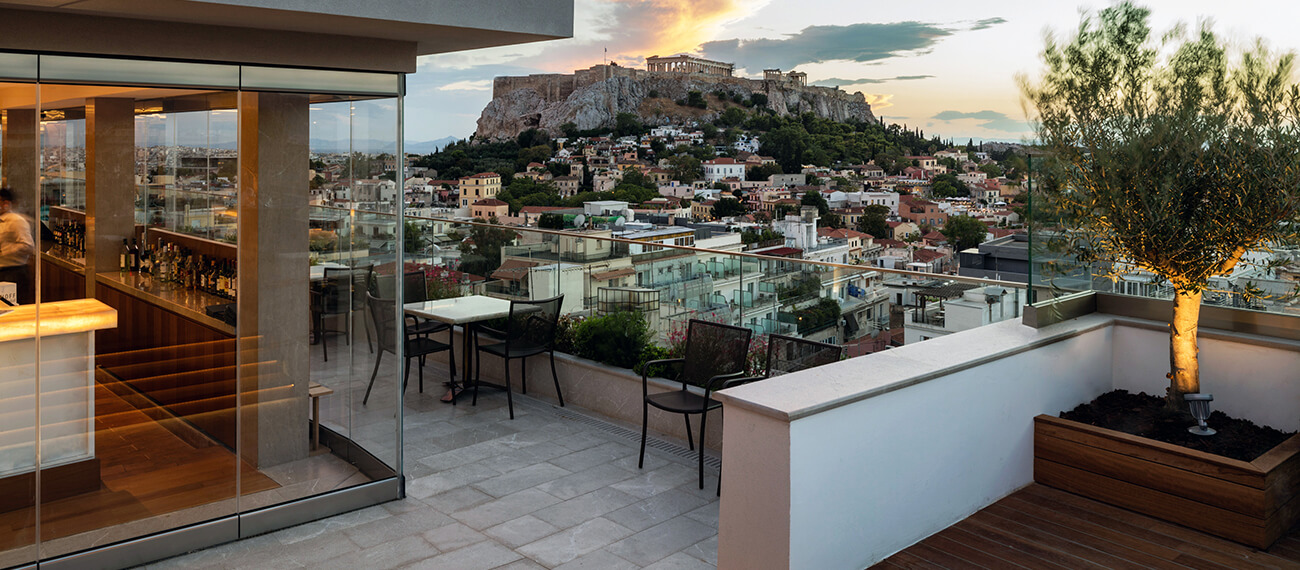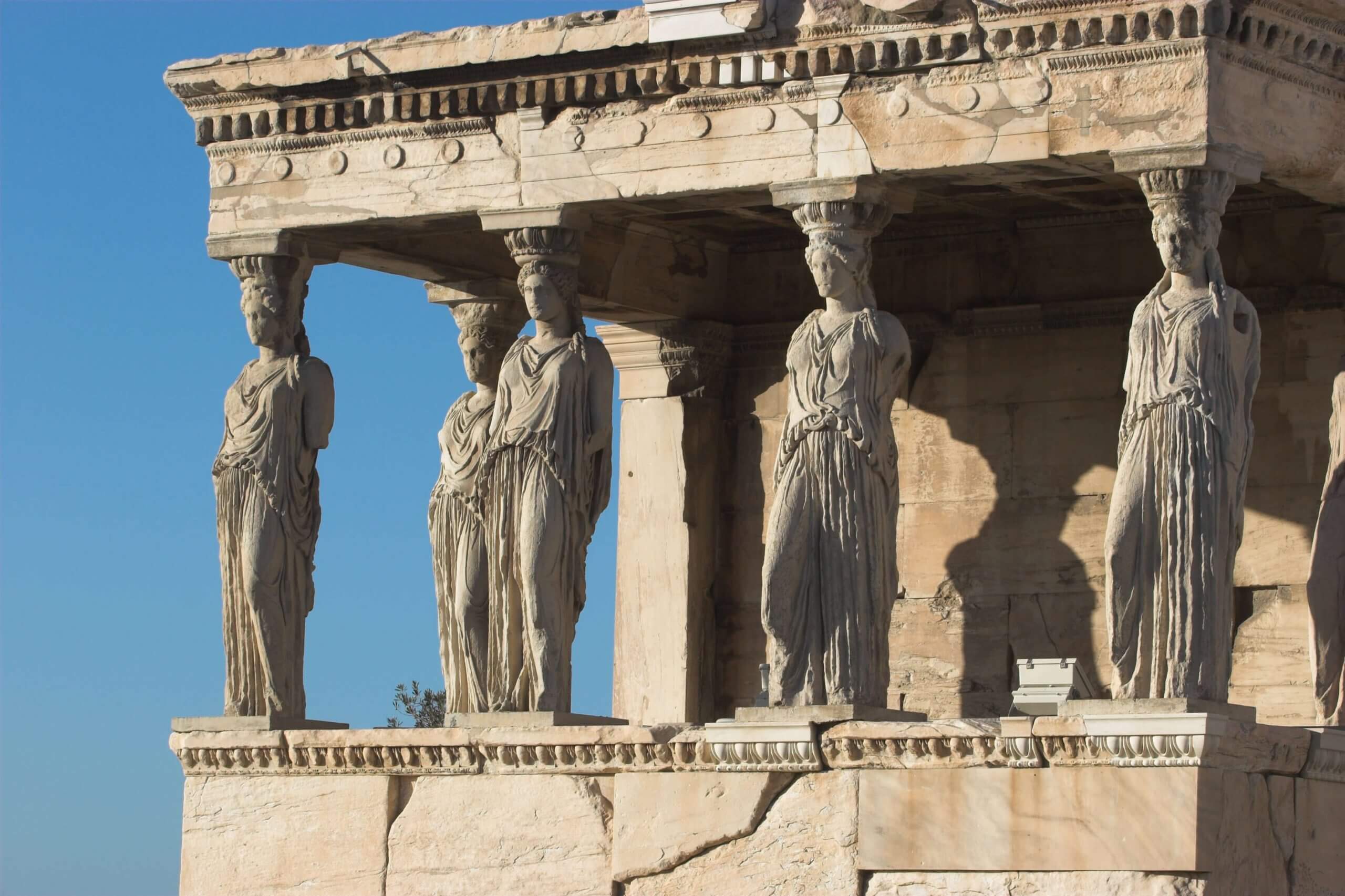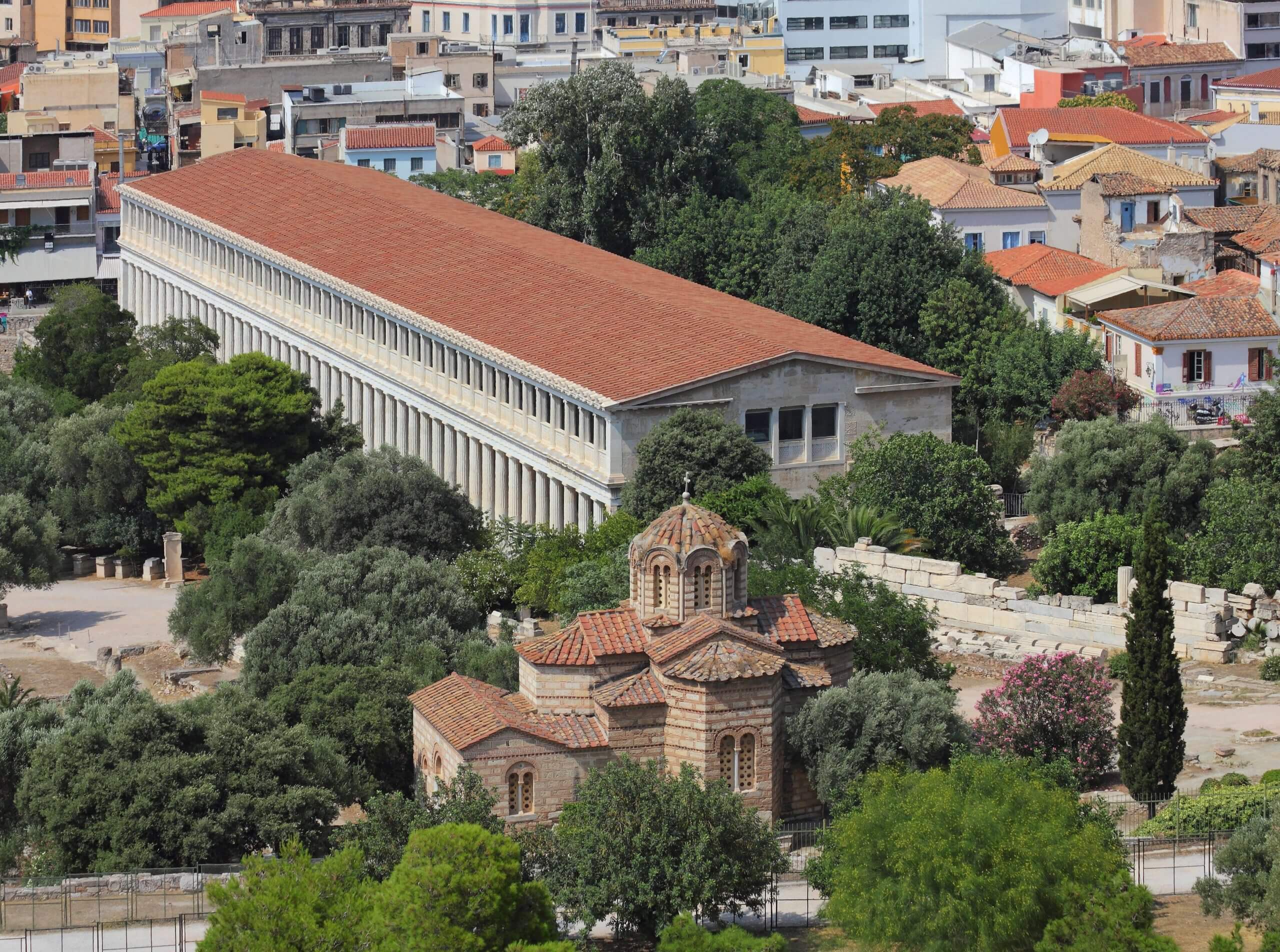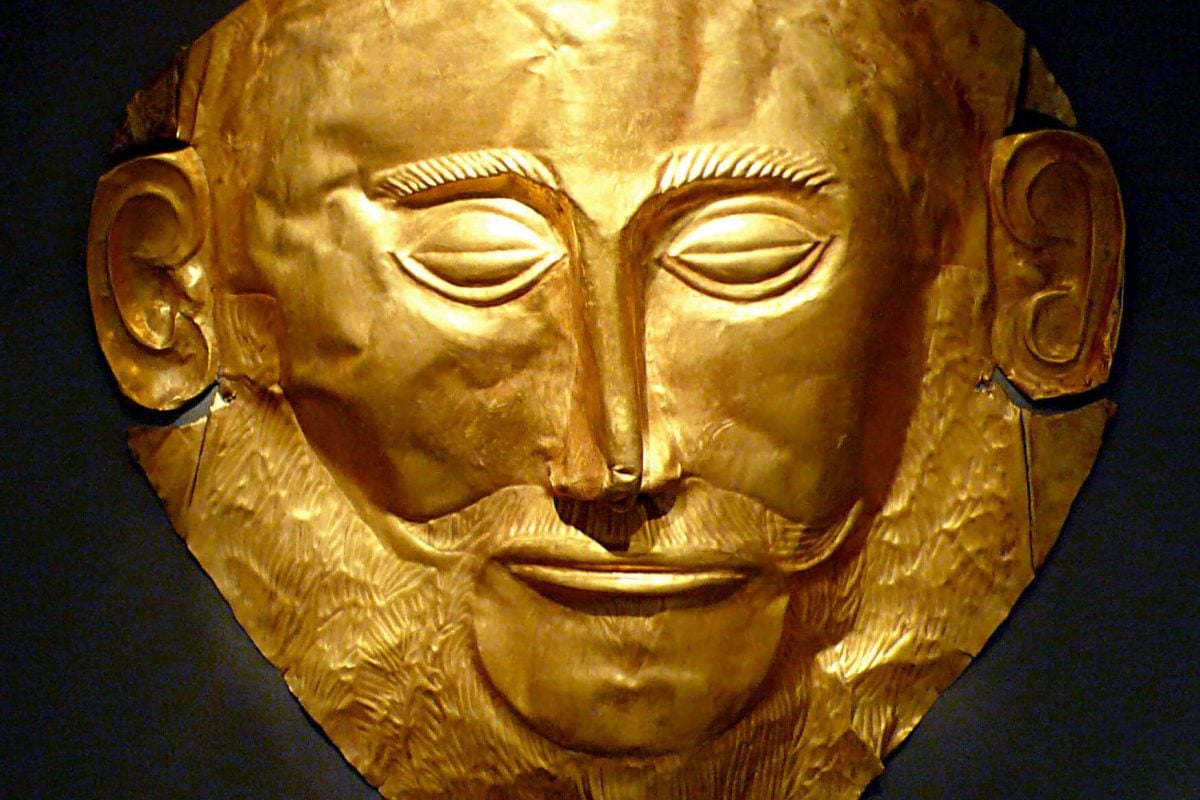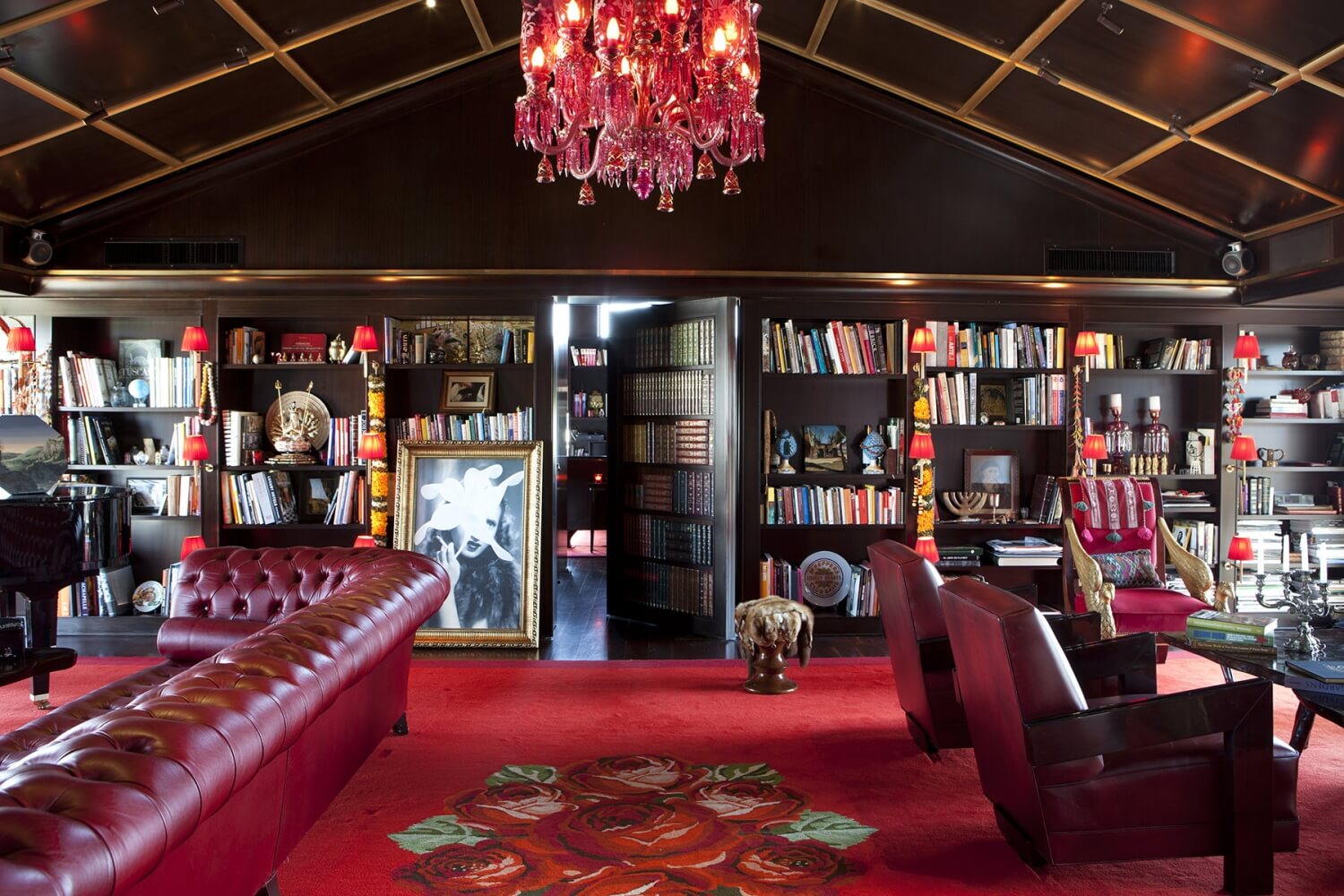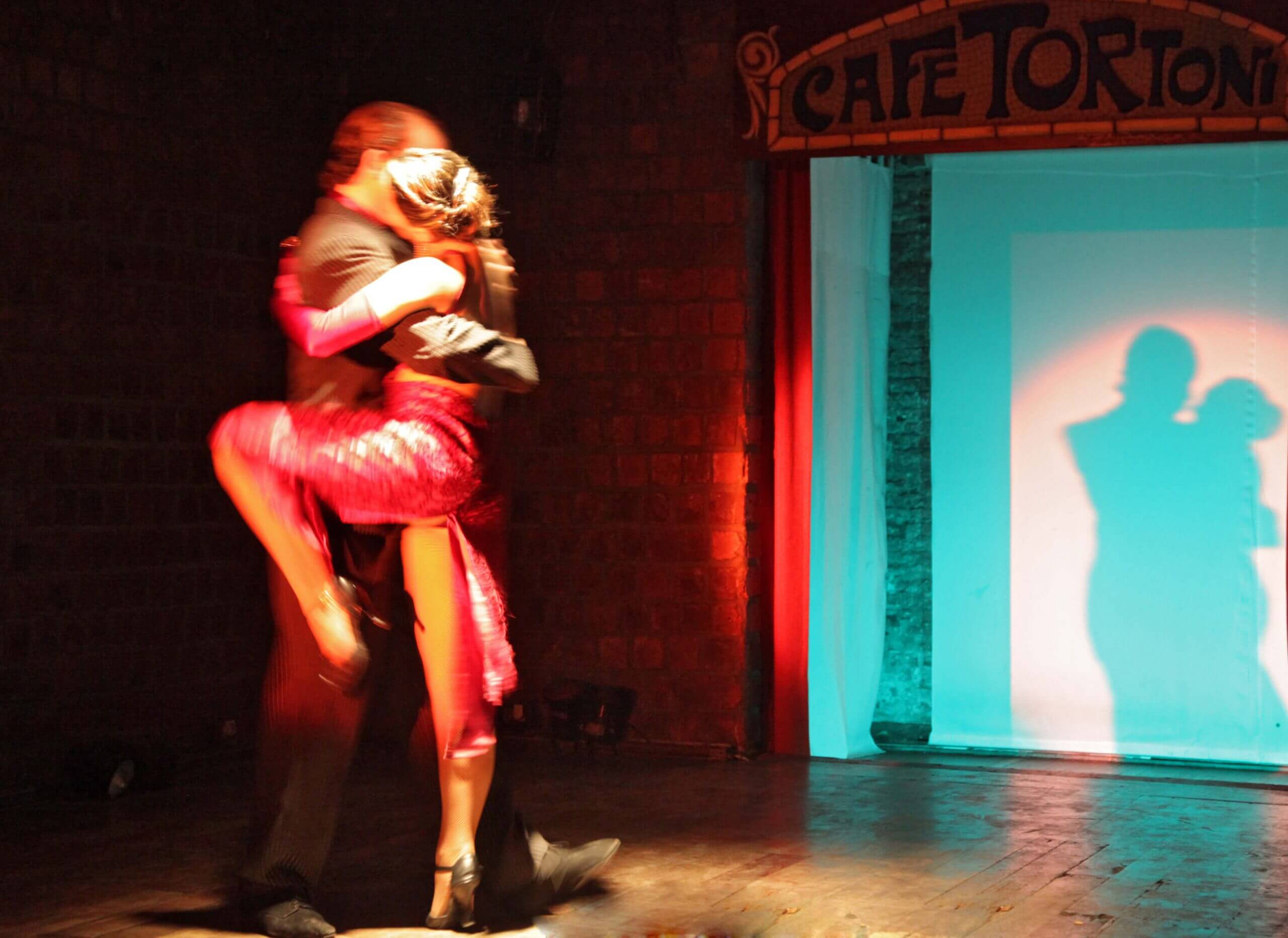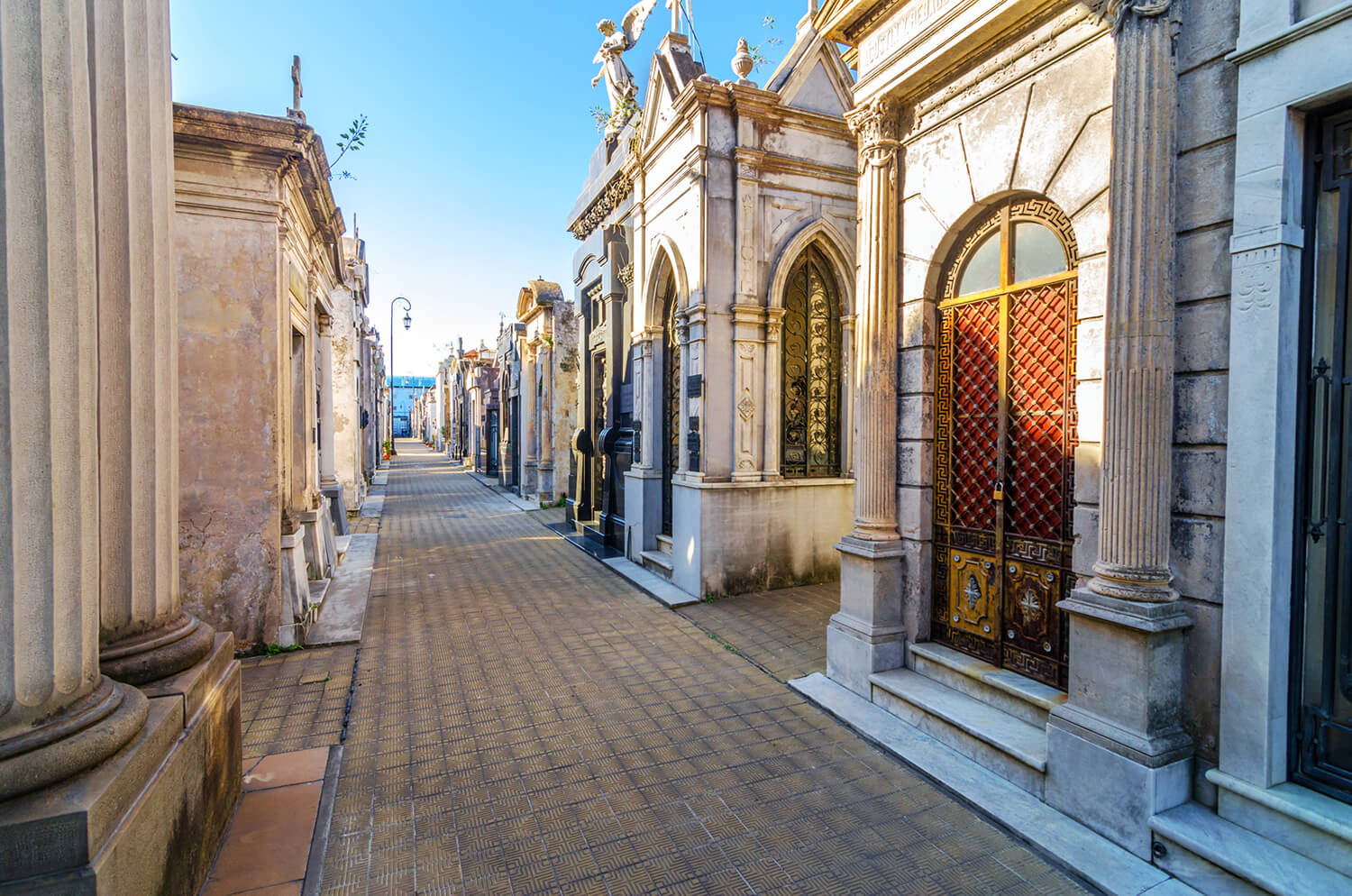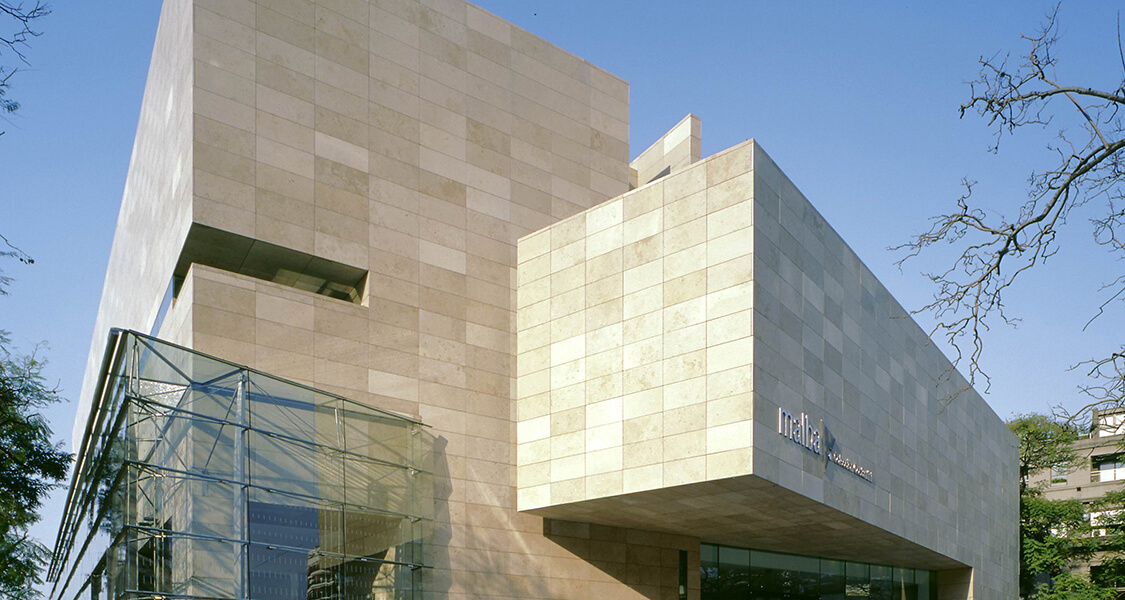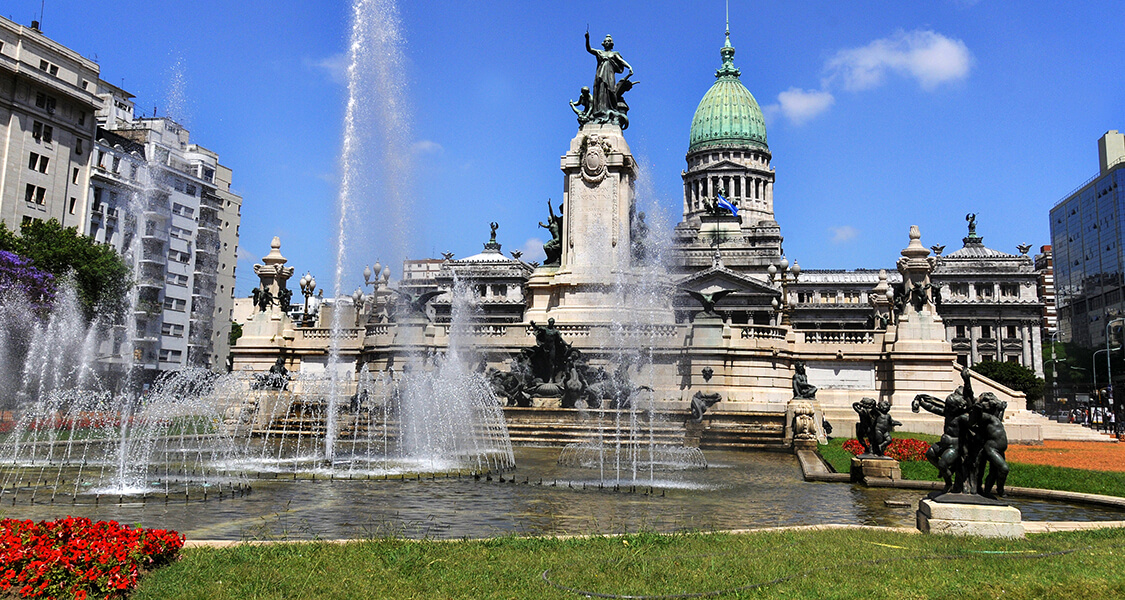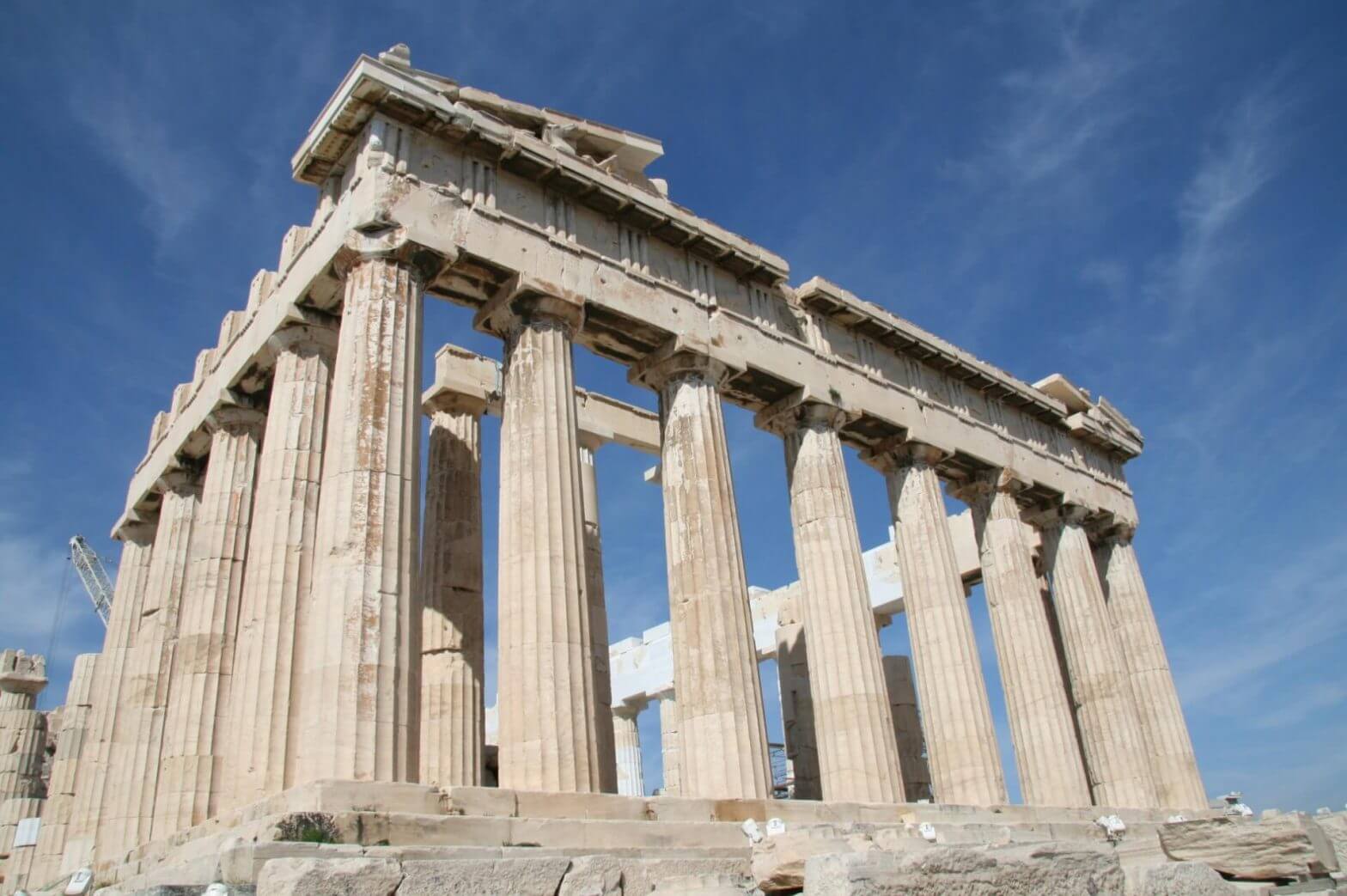
True, Athens can seem a little overwhelming at first. Between the majesty of the Acropolis, the vibrant colors of the Plaka and the non-stop energy of Syntagma Square it can almost seem like the Greek gods are conspiring to throw you a curveball: how can you possibly see it all when time is limited? First of all, relax. While you’d have to be crazy to think you can manage more than 3,400 years of civic history in the space of a weekend, you can actually take in a quite a bit in 48 hours—and still have time for people-watching over a tall frappé, just like the Athenians do.
With 48 hours in Athens, chances are you will be spending at least a few of them tackling the Acropolis, so why not get an eyeful of this starring attraction even before you set out? The vast, wraparound rooftop terrace on the tenth floor of the new Electra Metropolis Athens affords the best view of the Parthenon and Acropolis from any hotel in Athens, hands down. It does double duty as the hotel’s breakfast area and evening cocktail area and features a jaw-droppingly beautiful rooftop pool, too. The 216 rooms and suites pairs classic luxe looks (think hardwood floors and crushed velvet headboards) with modern conveniences and totally indulgent marble bathrooms. Rooms are from approximately $220 a night. (Hint: if they’re sold out, try the New Hotel nearby).
Electra Metropolis Athens
If the Acropolis is the most famous of Athens’ landmarks, the Parthenon (completed back in 438 BC) which graces the peak is its most emblematic. Because of the enormous cultural weight this place carries, you might want to give yourself some context before you make the nearly 500-foot climb and the best place to do that is at the ultra modern Acropolis Museum, situated at the base of the hill. Inside you can peruse some 4,000 artifacts in five collections, including finds from the slopes of the Acropolis and antiquities from the Greek archaic and classical periods. Go for lunch at the rooftop restaurant and enjoy panoramic Acropolis views. Museum admission is 5 euros.
As you make your way up the Acropolis itself (admission fee 20 euros; seasonal reductions) the first structure you’ll see is the Propylea, the monumental gateway of the ancient religious complex of which the Parthenon is the centerpiece. And if you’re not too distracted by the spectacular city views in all directions, also take time to inspect the Erechtheion, with its six stunning female Caryatid sculptures.
The afternoon is a good time to explore the ruins of the ancient Athenian agora, which is less dramatic than the Parthenon but no less evocative. This area lies just northwest of the Acropolis (it’s an easy walk) and contains numerous sights, including the recently restored Museum of the Stoa of Attalos and the remarkably well-preserved Temple of Hephaestus. Admission to the Agora can be included with Acropolis admission or as a separate (and less expensive) ticket.
After soaking up all that history, chances are you’ll be hungry. Tuck into some delicious grilled fish and Greek food classics right in the heart of the Plaka at Diodos (19 Adrianou St). Friendly service and Acropolis views will help make it a meal to remember.
Paris has the Louvre, Athens has the National Archaeological Museum. It’s a good thing you had a sound night’s sleep before, because it takes stamina to navigate the thousands of artifacts at what is incontestably one of the greatest museums in the world. Highlights include the gold mask of Agamemnon, the bronze statue of Zeus, frescoes from Akrotiri (the ruined Minoan city in Santorini said to be the original Atlantis), the Antikythera Mechanism—an ancient analogue “computer” recovered from a famous shipwreck—and more richly painted ancient Greek vases than you can count. Admission is 10 euros.
The Mask of Agamemnon, National Archaeological Museum
The neighborhood around the museum, Omonia, has little else to recommend it so after your visit is complete head to Syntagma Square, home to the Greek Parliament and Monument to the Unknown Soldier. This is where to see the iconic Evzones—traditionally dressed presidential guards—who rotate positions on the hour.
Syntagma is the heart of modern Athens and it bustles at every hour. For lunch, hit The Greco’s Project at 5 Mitropoleos St where you can either get an amazingly good gyros to go or sit down for a more leisurely plate of souvlaki, moussaka or any number of homemade Greek specialties. You can have a great lunch here for two for under 20 euros.
Evzones at Syntagma Square
In the afternoon, if you have any energy left (and of course you do—you’ve taken your cue from all those Athenians walking around with iced coffees, haven’t you?), explore one of the city’s fantastic, lesser-known museums. One is the Museum of Cycladic Art (admission 7 euros). Technically located in the upscale Kolonaki district, it’s a five-minute walk from Syntagma Square and a veritable treasure chest of antiquities from the Greek islands, Cyprus, Mycenae and more. If on the other hand you want to see the coins that Plato may once have used to buy Socrates a drink, check out the nearby Numismatic Museum (admission 3 euros), housed in the former mansion of Heinrich Schliemann—the notorious archaeologist who excavated Troy.
At night, hop on the modern Athens metro to Keramikos. From Syntagma Square this is just one stop after the Monastiraki stop. When you exit the station you’ll be in the heart of Gazi which is the epicenter of Athenian nightlife. One glance around the large main square, ringed with restaurants, cafés and bars, and you’ll get an instant refresher course on why cosmopolitan is a Greek word at heart. Almost anywhere you go here is going to be great, but do make time for a cocktail at the raucous Shamone (Elasidon 46) or something more substantial at Butcher Shop (not a real butcher shop) at 19 Persefonis St. Most bars in Gazi serve food too.
Athens is a truly a global city, and it shows and shines in the ancient monuments, the foodie and culture scene and in the sheer vitality of the Greek people who proudly make the capital their home. Two days of taking in the top sights won’t give you much time to rest, but it just might whet your appetite for more.
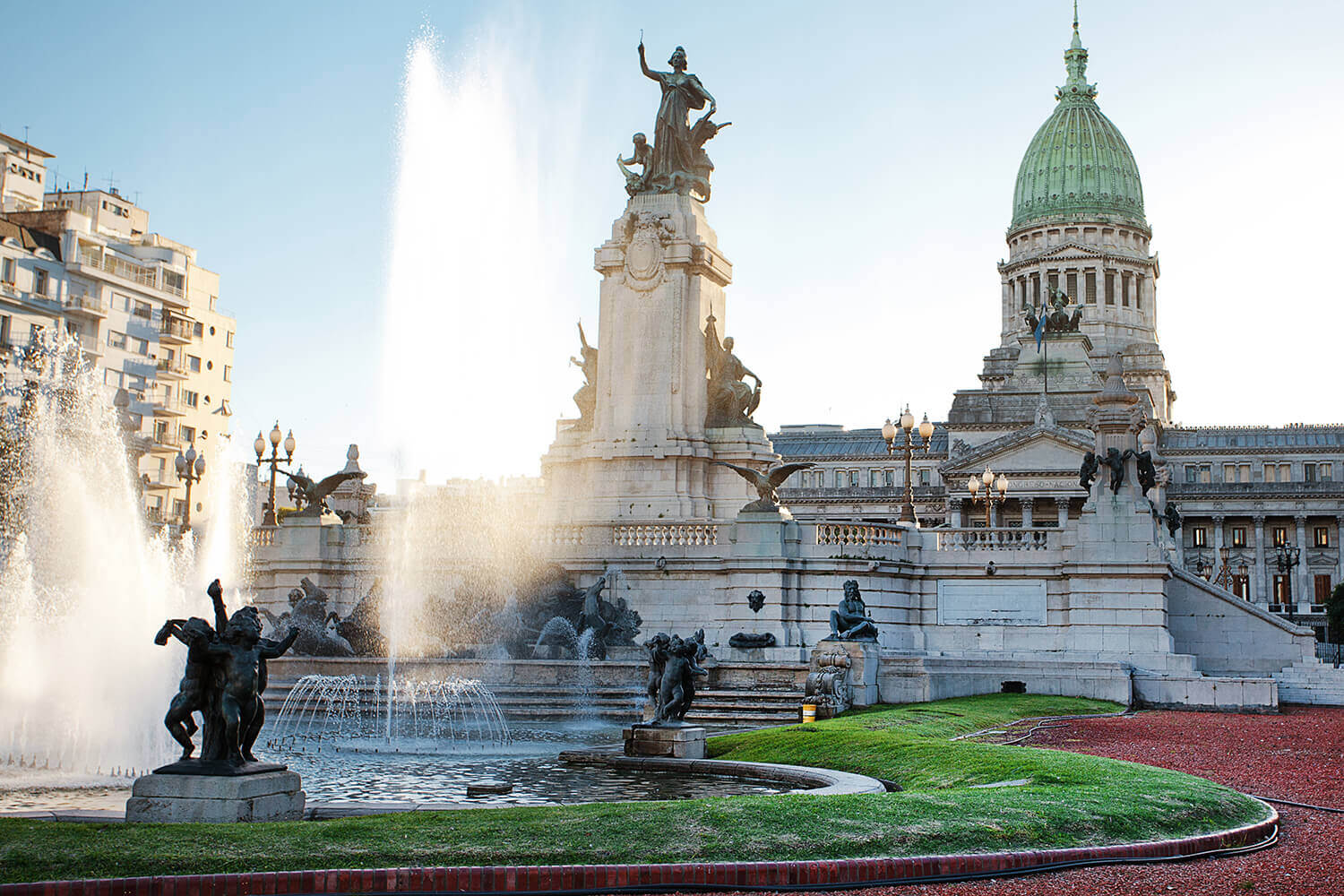
To start off, let’s check into the Faena Hotel, the highest ranked hotel in Buenos Aires. It “projects a low profile, but the interiors of the luxury hotel are bathed in rich reds and black marble, creating a sexy, dramatic ambiance,” says Forbes Travel Guide. Designed by the renowned Philippe Starck, “it’s the kind of place where you might easily find yourself sharing an elevator with Sting,” says Travel + Leisure. Rates start at $357 a night.
After you explore the hotel amenities, which include two on-site restaurants, a lounge that stays open late into the night, and swanky pool area, it’s time to see the neighborhood. The Faena Hotel is located in Puerto Madero, a waterfront district that buzzes with activity. “Sleek office buildings reach into the sky, trendy restaurants are filled with well-heeled locals, and a number of celebrities own places in the hood’s high-rise apartment buildings,” details Forbes Travel Guide.
After a walk along the Rio de la Plata, it’s time to head to Café San Juan, in the nearby neighborhood San Telmo. Getting there is easy: while Uber is still not available in Buenos Aires, Easy Taxi is an app that works the same way and is available throughout most Latin American countries. It accepts all major credit cards, and is available in most languages.
An Easy Taxi ride to Café San Juan will cost under $2.00 no matter the time of day. Just ten minutes away from the Faena Hotel, this family-run restaurant is where locals and tourists gather, and it would be wise to make a reservation. “During the daily lunch rush, chef Leandro Cristobal fashions inventive tapas and pastas from the likes of sun-dried tomatoes, brie and seasonal vegetables, while his mother pours the wine,” says Time Out. A meal here averages $30, including a glass of wine, but keep in mind that it’s a cash-only venue.
It’s now time to visit the city’s most famous landmark, Argentina’s National Museum of Fine Arts, or el Museo Nacional de Bellas Artes. An Easy Taxi from Café San Juan ($3) will drop you off in front of this impressive structure, in the heart of the posh Recoleta neighborhood. It’s open from Tuesday til Saturday, and admission is free. According to Travel + Leisure, “the best part of the museum is the Argentinean art—the most extensive collection anywhere. Apart from its intrinsic beauty, the collection gives a peek into life over the centuries, from the Italian immigrants of La Boca (an industrial port) to frontier life on the pampa.”
After touring the museum, you can view the sunset in the middle of the city’s Plaza de Mayo. Another $3 cab ride will take you to downtown, which houses the political institutions in the country. Surrounded by old neoclassical buildings, the plaza is filled with energy and history.
Once again, it’s time for a bite. Argentina is best known for its beef, and La Cabrera, is the place to taste some. Nestled in the Palermo neighborhood (a $4 cab ride from Plaza de Mayo), La Cabrera is also popular for argentines and tourists alike, so it is best to make a reservation. “Stick with classics from the grill, like sweetbreads, ribeye, short ribs, and stuffed pork bondiola (shoulder),” recommends Frommer’s. Dinner here will be just under $20.
A trip to Buenos Aires is not complete without a tango show. Luckily, the Faena Hotel has the “Rojo Tango” on at 10 pm. Get back to the Faena for $4 using Easy Taxi and enjoy the show for $17.
A trip to Buenos Aires is not complete without a tango show. Luckily, the Faena Hotel has the “Rojo Tango” on at 10 pm. Get back to the Faena for $4 using Easy Taxi and enjoy the show for $17.
Day one was packed with attractions throughout the city’s most iconic neighborhoods. Day two will be take place mostly in Recoleta and San Telmo, because they’re lovely for strolls. But first, there’s always a need for some good breakfast. Start the day at Café Tortoni. A $2 cab ride will get you there from the hotel, and it happens to be on the way to the next destination. Tortoni is an institution in Buenos Aires, with a charmingly ceremonial feel given its fame of attracting famous authors. “If there’s a spiritual, intellectual, and historical epicenter to Buenos Aires, this is it,” says Concierge. And coffee here is really good too.
Buenos Aires is huge, but walking the city’s streets is essential to captivate the porteño (as locals are called) essence. The best area to walk in is Recoleta, just a $2.50 Easy Taxi ride away. “Elegant houses reminiscent of their Parisian counterparts line the streets of chic Recoleta,” says Michelin.
During the stroll, be sure to check out the Recoleta Cemetery. Just like Père Lachaise in Paris, Buenos Aires is elegant enough that a cemetery can be worth visiting. Travel + Leisure notes that, “with more than 4,700 ornate stone crypts laid out along a streetlike grid, this graveyard is an architectural masterpiece, and an eerie miniature city for the wealthy dead.”
After all that strolling, it’s time for lunch. Luckily, it’s walking distance. The highly recommended Oviedo promises a memorable experience. In a meat-centric city like Buenos Aires, Oviedo is known for offering some of the best seafood. Fodor’s says that, “you can’t go wrong with any of the pristine shellfish dishes. Top it all off with one of the better wine lists in the area and you’re in for a memorable lunch or dinner.” Lunch here can range from $25 – $100.
MALBA and the Plaza Dorrego
It’s now time to say goodbye to Recoleta and head over to the MALBA to peruse some of Latin America’s finest art. An Easy Taxi ride of $1.50 will take you to this museum, which Lonely Planet calls “one of BA’s fanciest.” Some work by the dynamic duo of Mexicans Diego Rivera and Frida Kahlo is on display. General admission is $4.50.
Another quick cab ride ($3.50) will take you to Plaza Dorrego, which will be especially nice at dusk. Known for the vendors, cafes, and tango on its streets, this colorful plaza in San Telmo is best enjoyed on Sundays. According to our experts, San Telmo gives Buenos Aires that bohemian air that somehow works so well next to the posh neighborhoods of Recoleta and Puerto Madero.
While in San Telmo, history buffs cannot miss out on visiting El Zanjon de Granados. Part archaeological museum, part event space, El Zanjon is a restored residence that encapsulates three centuries of urban living. “Expect few visitors and plenty of atmosphere on weekdays; cheaper, shorter tours on Sunday draw far more people,” recommends Fodor’s. Depending on the day, a tour will cost from $11 – $13.
A last meal in Buenos Aires is difficult to choose – the city is filled with great restaurants. The best choice would be Tegui, where ten-course meals are the norm. There’s something for everyone in this Palermo venue that was recently awarded for being amongst the best in Latin America. A $5 ride from El Zanjon will take you to this seemingly discreet façade, which hides high-concept cuisine. Travel+ Leisure recommends the “gnocchi and sweetbreads, rabbit terrine, and very slowly braised lamb.” A meal at Tegui starts at $40.
Take one last Easy Taxi ride to the Faena Hotel for $5 before you enjoy some rest from walking your way through Buenos Aires. While 48 hours is quick, go to bed knowing that you saw the top attractions and ate in the best restaurants while gallivanting through the Argentinian capital. It’s not an easy task to take in a huge city like Buenos Aires in two days, but with this itinerary, it can definitely be done well.
Just another WordPress site
